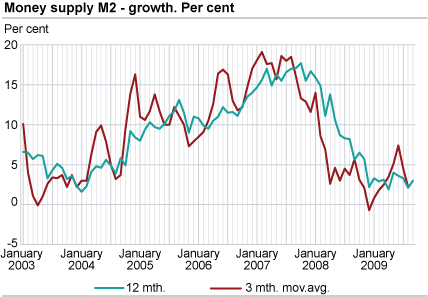Content
Published:
This is an archived release.
Rise in money supply growth
The twelve-month growth in total money supply was 3.0 per cent to end-September, up from 2.1 per cent to end-August. Most of the increase in the M2 growth came from enterprises (both other financial and non-financial enterprises).
The money supply amounted to NOK 1 503 billion at end-September, down from NOK 1 504 billion at end-August.
Increased growth in non-financial enterprise and other financial enterprise money supply
Non-financial enterprise money supply amounted to NOK 505 billion at end-September. The twelve-month growth was -0.3 per cent to end-September, up from -0.8 per cent to the previous month. Non-financial enterprise money supply constituted almost 43 per cent of their gross domestic debt measured by the credit indicator C2 at end-September. As recently as in December 2007 this ratio was higher than 50 per cent.
Other financial enterprise money supply (other than state lending institutions, banks and money market funds) amounted to NOK 133 billion at end-September. The twelve-month growth was -1.5 per cent to end-September, up from -7.4 per cent to the previous month.
Rise also in household money supply growth
At end-September, more than half (NOK 811 billion) of the broad monetary aggregate was owned by households. The twelve-month growth in household money supply was 5.8 per cent to end-September, up from 5.7 per cent the previous month. The growth in household money supply was lower than the growth in household gross domestic debt, which was 6.4 per cent to end-September, as shown by the credit indicator C2 . For more information on the financial position of households, see the financial accounts in the national accounts .
| April 2009 | May 2009 | June 2009 | July 2009 | August 2009 | September 2009 | ||||||||||||||||||||||||||||||||||
|---|---|---|---|---|---|---|---|---|---|---|---|---|---|---|---|---|---|---|---|---|---|---|---|---|---|---|---|---|---|---|---|---|---|---|---|---|---|---|---|
| M0 - 12 mth. | 80.6 | 72.1 | 59.1 | 116.1 | 18.7 | 22.7 | |||||||||||||||||||||||||||||||||
| M1 - 12 mth. | -4.5 | -1.3 | -1.8 | -0.5 | -1.9 | 1.8 | |||||||||||||||||||||||||||||||||
| M2 - 12 mth. | 1.9 | 4.0 | 3.6 | 3.3 | 2.1 | 3.0 | |||||||||||||||||||||||||||||||||
| M2 - 3 mth. moving average | 3.5 | 5.1 | 7.4 | 4.5 | 2.2 | ||||||||||||||||||||||||||||||||||
| M2 households - 12 mth. | 6.2 | 6.2 | 5.9 | 5.9 | 5.7 | 5.8 | |||||||||||||||||||||||||||||||||
| M2 non-financial enterprises - 12 mth. | -0.8 | 2.7 | 1.6 | 2.4 | -0.8 | -0.3 | |||||||||||||||||||||||||||||||||
Composition of money supply
The broad monetary aggregate M2 amounted to NOK 1 503 billion at end-September, of which the major part (91.0 per cent) consisted of bank deposits. In comparison, notes and coins only accounted for 3.0 per cent of the broad money. The rest of the broad money mainly consisted of shares in money market funds (5.7 per cent), while certificates of deposits accounted for 0.3 per cent.
|
The money supply (broad monetary aggregate) M2 consists of notes and coins, unrestricted bank deposits, certificates of deposit and units in money market funds owned by the money-holding sector i.e. households, non-financial enterprises, municipalities and financial enterprises other than state lending institutions, banks and money market funds. |
|
The base money (M0) is defined as the banks’ and the money-holding sector's (see above) notes and coins and deposits with Norges Bank. Banks’ deposits with Norges Bank comprise current account (sight) deposits and fixed rate (time) deposits (F-deposits), from Norges Bank’s monthly balance sheet. |
The statistics is published with Monetary aggregates.
Contact
-
Statistics Norway's Information Centre
E-mail: informasjon@ssb.no
tel.: (+47) 21 09 46 42

